Look, I work hard and I provide for the family; I do right by them but has anyone done right by me? It feels narcissistic to write this. I'm not the sort to make a hullabaloo about my birthday, let alone, Father's Day. But times are changing. Credit needs to be given to where credit's due. As a father, I suppose, it's okay to indulge a little.
So, colour me surprise when Pullman Singapore Orchard has a promo for the dads. After the hotel's "Pull-Mum" Singapore Orchard Getaway, Pullman Singapore Orchard decided to be an equal opportunity rewarder and do something for the daddies (I'm assuming the getaway applies to the "baby" and "sugar" variety). This Super Dad Father’s Day Getaway is a 28-hour experience that involves a stay, food, swimming and cocktails.

Every Super Dad Father’s Day Getaway lets you check in at 10am. That's right: 10 in the morning. And you can also have a late checkout at two in the afternoon. And the room that you check into is a Deluxe Premier Room—a 32 sqm space that has a king-sized bed and a smart en-suite bathroom with a bathtub and shower (our room faces Orchard Road; Mandarin Gallery, specifically). Step into the room and you’re greeted with a selection of macaroons and chilled, locally-brewed Trouble Brewing beers.
With SGD50, you can spend it at Eden Restaurant, PSO Beach Club or Atelier Lounge. If you're feeling peckish, head to Eden Restaurant that's fashioned to look like a glasshouse. With light streaming through louvres, it bathes the place in a natural and appealing hue. Currently, there's a special on lobster dishes. We had a Boston lobster that's cooked in a Shaoxing wine and comes with lala and mussels. Of course, you have a side of sourdough bread for the sopping up of the sauce. There's also a complimentary glass of Guinness or red wine.

You can relax at the pool at PSO Beach Club. Or, if you're like me, you can partake in the two-hour cocktail master class at Atelier Lounge. Situated next to PSO Beach Club, the bar is tended by Presh, showed us the finer points of drink mixing. She walked us through how to whip up a few specialty cocktails like the Eden's Affair (The Botanist gin; rinquinquin; lemon juice; basil leaves and Sprite) and a PSO Fig Sling (The Botanist Gin; Cointreau; Capano Antica Formula; pineapple juice; lime juice; orange bitters; a fig). There's nothing like shaking up the drink and sipping on your handiwork (and free-flow bubbles, cocktails, wines and mocktails) while watching a stately swan floatie gracefully glide across the window.
We haven't got to the best part yet.

In the morning, instead of dragging your feet down to the restaurant fro breakfast, you can opt for BREAKFAST IN BED. That's right. For the Super Dad Father’s Day Getaway, you can choose from a several breakfast items and have them delivered to your room. Sure, there's that risk of the child, accidentally spilling juice all over the duvet but BREAKFAST IN BED. It seems odd that we are easily excited about this but BREAKFAST IN BED is such a Westernise concept that we romanticised in our head to the power of seven that we couldn't pass up on.
If you want to upgrade the Super Dad Father’s Day Getaway package, you can get a car transfer at SGD85 per trip or add SGD70 for access to the Archive Club, which is kinda-like an executive lounge, where you get to nosh on specialised all-day offerings and free-flowing Maxime Blin Champagne. At 5pm, Archive Club will dole out a selection of 12 wines that you can choose.
The Super Dad Father’s Day Getaway at Pullman Singapore Orchard runs until 30 June, 2024.

“I’d rather gnaw a bean than be gnawed by continual fear.”
- Odo of Cheriton
Let us consider Arthur Schopenhauer’s view that all life is suffering. As a student of Kant and Buddhism, Schopenhauer said that as all living creatures are possessed by a will, there is a constant drive to satiate one’s needs to survive. This “striving” is what Schopenhauer refers to as “suffering”. We work to earn a paycheque; we struggle with our self-esteem in our social lives—the latest trend to adopt; how to look appealing; fitting into society’s parameters. And when we do get what we want, it’s not enough. Life’s fleeting nature pushes the boulder back down the hill and, in our efforts to survive, we roll it back up again. Repeat as needed until our ticker runs down.
Schopenhauer’s solution to limiting our suffering was by limiting our desires. “Those who, with too gloomy a gaze, regard this world as a kind of hell and, accordingly, are only concerned with procuring a fireproof room in it, are much less mistaken. The fool runs after the pleasures of life and sees himself cheated; the sage avoids evils.”
But Schopenhauer’s student, Friedrich Nietzsche, had a different take. Yes, life is suffering, but for Nietzsche avoidance isn’t the answer; it is to roll with it. Suffering and death are inevitable fates but you can make something of the experience.
This is probably why Nietzsche > Schopenhauer.
EVERY DAY, YOU ARE BOMBARDED by news of war; injustices; inflation. Worry leaves its trail on your face. Sleep becomes a distant land. The world can only cut you down so many times before there’s nothing left. A slow death by a thousand cuts. What can you do: you escape the city. RAKxa Wellness & Medical Retreat sounds inviting. It appears like some fabled sanctuary; Shangri- La peered through the mist.
It is 50 minutes by car from Suvarnabhumi Airport, and the travel to RAKxa is a passenger window of highways, then buildings before it segues into residential houses and then green rural stretches. RAKxa is nestled at Bang Krachao, Bangkok’s Green Lung—a man-made conservation in the middle of the Chao Praya River. It’s an island that’s circled by mangrove trees and jungle foliage runs wild.
You arrive at the pavilion, where you are greeted with a cool drink and a ceremonial sounding of the singing bowls. It feels like you’ve stepped into another world. Briefly, a thought about checking your work e-mails enters your mind before you’re whisked away to your villa.
It’s a sprawling compound. Villas, frangipani plants and banana and casuarina trees zip past as you’re ferried by a buggy. There are three treatment facilities at RAKxa. There’s RAKxa JAI, the retreat’s holistic wellness centre. This is where traditional treatments are used like acupuncture or sound baths. RAKxa GAYA is a “medical gym” due to its diagnostic approach. Then there’s the VitalLife Scientific Wellness Clinic, outfitted with the latest tech-based equipment that can perform Light Therapy or cyrosaunas. VitalLife also excels in its anti-ageing treatment, which you take with a grain of salt. Unless you’re Benjamin Button or Paul Rudd, no one ages in reverse or stops ageing. You’re of the camp that you can only slow down the ageing process through exercise and a proper diet. Then again, you’re also of the camp that you’d be open to new experiences.
It feels like the compound is larger than expected since you don’t see any other patrons. There are the staff that tend to the centre but they sort of melt into the background. You don’t quite notice them until you’re in want of something, then they appear. One can get around by the aforementioned buggy but walking is not too far out of the realm of possibility. After all, this is a wellness centre. Motion is health, goes the saying.
The villa is spacious. Windows stretch from floor to ceiling, visually admitting the surrounding verdant landscape. An environmental monitoring system keeps the room at a comfortable temperature as your frontal cortex is assuaged by the warm earth tones of the interior. You could sink into your bed, cocooned by the hypoallergenic bedding but you’ll miss out on the private garden. Or sit on the terrace, nurse a kombucha and soak in the serenity of your little slice of Eden. You sort of forget that across from the horseshoe-winding Chao Praya River, the bustle of Bangkok’s city life continues unabated.
(RAKXA WELLNESS & MEDICAL RETREAT)
HERE’S WHAT YOU DIDN’T KNOW: RAKxa was originally supposed to be a clinic with a room to stay at. But before she became RAKxa’s founder, Dusadee Tancharoen was a high-flyer until a medical diagnosis clipped her wings; and she turned her focus towards health and wellness. She saw value in the medical and holistic fields in the wellness industry. Reiki; ayurvedic; acupuncture; cyro sauna; hyperbaric chamber therapy; colonics (don’t snigger)... all these are serious fields held in high esteem. These and more are integrated into RAKxa’s programmes. While some treatment programmes are pre-planned, others can be tailored to return you to your optimal self.
You’d undergo a consultation with several Health & Wellness Advisors. Then, an itinerary of treatments is drafted to match your needs. The consultants across the medical fields were mostly unanimous in their diagnosis: there’s something “stuck” in you. An obstruction. You run hot; there’s a wind in your tummy; there’s an imbalance; your energy is dammed by a blocked meridian point. It’s the same diagnosis repeated in different languages.
And you know this. For far too long, the lack of sleep turns into a meaningless badge of honour. The suffocating stress feels like a hair sweater. What was intrusive has now become a bedfellow. A hairline crack that has widened into a gulf over the years. It has become so normalised that you need to detach from it; step outside of yourself as it were. Inhabit a third-person perspective that allows you to be open to what these treatments, no matter how new age-y they are, can offer.
RAKxa’s treatments sound a little “out there” if you know what I mean. But you’d try anything once. Especially, when you’ve tried everything else. You lie through a session where your therapist’s hands hover over your body as a way to “heal you with energy”. You are bombarded with sonics from bronze bowls in an effort to align your chakra. A photo-light therapy blasts you with light energy to aid in skin and muscle regeneration. Super cold air bathes your body to improve blood circulation. Tiny needles dot your body to stimulate specific anatomic sites.
They will put you on a vitamin IV drip to boost your immunity. Can you feel the cocktail of vitamins infused into your bloodstream? Do you feel better, albeit slightly? Is the tranquil scene of nature shown through the window helping you be centred? Or do you take this opportunity to answer e-mails and dink around on the laptop?
No matter how far you run, you still can’t leave the world behind.


RAKXA’S RESTAURANT, UNAM, PUTS out surprisingly good food. Not that you went in thinking that there was a McDonald’s nearby to fall back on if the meals weren’t up to snuff, but the dishes punch above their weight. The menus are made from chemical-free ingredients that are supplemented with sustainable meats and seafood. There’s always a starter of kombucha, followed by the mains, then dessert. After your initial consultation, the restaurant will tailor the menu. Mention in passing that you don’t like ginger and they will excise the herb from the meal plan.
“Health is wealth” is RAKxa’s motto. It won’t specifically cure you of your ailments, rather it is in the business to prevent calamities. But how else are you supposed to stave off the bad-ness if you’re already affected? Isn’t the solution then, to cure you? It’s a chicken-and-egg scenario and this thought runs laps through your mind as you’re lying in a hyperbaric oxygen chamber.
You’re undergoing hyperbaric oxygen therapy where pure oxygen is pumped inside a pressurised environment. Said environment is a horizontal unit, where you can lie down. The technician offers another less claustrophobic unit, one where you can sit upright during the process. But you opt for the “coffin”; you’ve always admired the dead for sleeping well so here’s a chance for that.
Except, being in a pressurised chamber means you’re constantly popping your ears for the first 10 or 15 minutes. Then silence sets in, but your mind starts filling in the blanks and somehow you leap from RAKxa’s motto to musing if there was ever a scene of an accidental spark in an oxygen-rich environment in any of the Final Destination films. (Answer: yes, in the second instalment.)
At RAKxa GAYA, a personal trainer puts you through a Functional Fitness assessment. Using state-of-the-art equipment to evaluate an individual’s fitness level and identify key risk areas that can lead to injury. The final analysis: your balance, stamina and strength check out great. Not looking fantastic: your flexibility. Still, the results are encouraging but while the physical is in the upper percentile, mentally, you’re thinking about next week’s work schedule. They offer several exercises to improve your mobility. “Yoga,” they say. You retort that it’s too slow-paced. The trainer looks at you as though he has heard that before. “You need to slow down,” he says as he glances at your chart. “Yeah. Tai Chi can do that.”


YOU’RE FAMILIAR WITH TAI CHI because one of your core memories was of you as a secondary school student, passing by a basketball court filled with geriatrics every morning. Their glacier movements, all in rhythm to some unidentifiable Chinese instrumental blasting from some unseen radio.
Now, it feels a little lackadaisical as a well-meaning RAKxa instructor puts you through the paces. You’re unfamiliar with this speed of activity. Your arms make soft and circular movements in a flowing form as your feet slide from one position to the next. The gestures are alien. You’re aware of your breathing, how languid you’re drawing in the air and the soft expulsion through your nose. There’s a mirror in front of you and you’re trying to hit your mark.
Maybe you’re a little self-conscious. If your younger self sees you now, will they roll their eyes? Make a snide remark? You don’t know because the thoughts never enter your mind. Right, now you’re focused on the next pose. And the next.
And then, strangely, you don’t think about them at all. Weirdly enough, you’re flowing from one movement to the next on instinct, much to the instructor’s surprise and elation. He is effusive with his praise, so much so that it borders on condescending. But for the next 20 minutes, the outside world seems far away. The weight of the smartphone in your pants pocket dissipates. Maybe the effects of the treatments are kicking in. Maybe this is what it has been needing: this forced retardation of actions.
For the first time in forever, you find yourself where you’ve always needed to be at: present.

I was told that I would not recognise Shenzhen on my arrival this time around. In four decades, what was once a quiet fishing town has since transformed into one of China’s top smart cities. Hometown to telecoms giant Huawei, amassing skyscrapers that share centralised air-conditioning systems for sustainability, the Silicon Valley of China currently stands as a modern miracle.
So, somewhat anti-climactic to admit that I would not be able to discern the difference regardless. I was barely a fledging the last time I visited, over half that duration ago. The only thing I recall is its proximity to Hong Kong, which has not changed. A health-declared hop, checkpoint-cleared skip and a 15-minute train ride away, I find myself in the thriving tech hub.
Then, at the foot of the reason I returned: the first Conrad hotel to open in the Qianhai area. The latest addition to Conrad’s portfolio overlooks the expanding business district on one side and Qianhai Bay on the other. All 300 rooms and 28 suites offer views of either, starting from a generous 56 square metres.

While it is common for hotels not to meet the tentative launch date generally used as a guide, Conrad Shenzhen had, in fact, surpassed the targeted timeline with its early completion. Not surprising, when construction here works around the clock in shifts. It may not be an exaggeration to say new towers pop up every month.
If the rapid rag-to-riches (or rather, village-to-metropolis) growth seems familiar, there are many other parallels with our own model development. “It’s like Singapore here,” the Conrad team enthuses, “Everything is constantly changing and moves very quickly. We call it ‘Shenzhen speed’.”

It is intriguing, thus, to see how the narrative of this evolution is woven into the hotel’s aesthetics. The first to greet guests at the entrance is “The Two Forms”; a pronounced sculpture rooted in yin and yang ethos that depicts the origin of the world. Symbolising the birth of Shenzhen and the nascence of the hotel, I personally saw it as a great signifier of the artful journey that begins upon entering.
I say that because there are over a hundred artworks on display throughout the 23 floors, with 17 major ones from notable local artists. All express traditional Chinese philosophies, the cultural ties of the city, or hopeful intent to the viewer in their individual ways and mediums. Most prominently, the two fishing village-inspired installations by Palace Museum’s antique restorer and young scholar Huang QiCheng, as well as his pièce de résistance above the reception.

These elegant motifs carry into the rooms. “The Fishing Boat in the Evening” (with a far more poetic name in Mandarin) by Austrian artist Rica Belna reimagines casted sunlight and fishing nets through a contemporary lens. Its placement is also an easter egg for guests, and that’s the only hint I will give
about it.
Accents like bathroom hardware and fixtures take decorative cues from the silhouettes and navigation elements of a ship. Together with palettes of muted tans and rose-copper tones to burnished gold and ambient browns, it’s impressive how cohesive the visual direction crafted by world-renowned design firm YABU Pushelberg is.
I’m particularly fond of the lobby’s layout which draws from a Chinese architectural principle key to Guangdong and Shuzhou heritage houses. The fifth floor is partitioned into three “in” and “out” sections, clearly demarcating the front desk, lifts and dining establishments into pockets whilst still sharing the main space.

Dining is another aspect that would be unfair to leave out. There’s Chinese restaurant CH’AO, in reference to what Teochews refer to as Chaozhou cuisine, showcasing locally sourced seasonal ingredients. The experience contrasts between beholding a bold spectacle of gastronomy in the open kitchen and savouring humble but meaningful homage to ancestral food.
Things take a different turn at The Common Room. By morning, a versatile purveyor of choices. You won’t regret the Shrimp-broth Seafood Congee from the a la carte menu, but the open buffet’s variety easily makes you anticipate every breakfast. Come noon till dark, it shapeshifts into a French degustation of courses like Velouté De Fenouil à La Normande, Truffle Fois Gras Mousse, and Halibut with artichoke barigoule served under a creative fish skeleton garnish of seaweed.
The restaurant shares its nine-meter ceilings with Azaleas lounge for light bites and signature afternoon tea. The outdoor terrace leads to Collective Bar, which awakens at dusk. This is where they prove the best thing to compliment an alfresco cocktail is amazing grilled delights and front-row seats to the sunset. As you settle into the patio’s plush velvet chairs, you may just spot the next big thing the speedy city is working on.
Conrad Shenzhen is located at No. 5001 Tinghai Road, Nanshan District, Shenzhen 518066, Guangdong Province, China.

The Hari Hong Kong is located between the bustling area of Causeway Bay and buzzing Wan Chai. Gaining ground as the epicentre to experience these vibrancy, the hotel combines the urban sophistication of a downtown art studio alongside all the creature comforts of a luxurious upscale hotel.

Step through the hotel's entrance and be greeted by lush leather booth seats and bookcases lined with art-inspiring tomes. British interior architect Tara Bernerd and Dr Aron Harilela, chairman and CEO of Harilela Hotels, conceptualised the decor.

Head to the hotel's third floor lobby, where the design approach is extended with plush mid-century modern interiors. An extensive display of artworks on the walls are curated by London-based art consultancy, A Space for Art. A modern luxury and social dynamism surrounds the bustling bar and restaurant scene. Mixed with old and new architecture, the charm of The Hari London is married with the vitality of Hong Kong.

The Hari Hong Kong boasts 210 guest rooms across 30 floors. Including three signature rooftop suites, which are all accorded the same design story of luxury comfort. From large plush beds decked out in Mühldorfer bedding to marble bathrooms fitted with rainforest showers. The Hari-scented La Bottega products fill the air. The Corner Rooms and Premium Corner Rooms offer a bird's eye view of Causeway Bay, Admiralty and Wan Chai in their neon-lit glory.
Feast at The Hari Hong Kong's two dining establishments: Italian restaurant, Luccioloa and Japanese izakaya, Zoku. Helmed by Piedmont-born chef Francesco Gava, Lucciola is a contemporary ode to heritage flavours. It showcases the best seasonal Italian produce in classic pasta dishes and mains, like Pennette al Ragu di Peperone Calabrese e 'Nduja and Orata di Orbetello in Crosta di Sale.
Oozing a bastion of old-world glamour with a modern, sumptuous interior and a bold palette of gold and green, a visit to Lucciola is not complete without a tipple or two. Choose from an aged liquor picked from the digestif trolley. Opt for a classic cocktail shaken tableside by the suave, crisp-white-jacket-donning bartender or a red selected from a list that takes diners on an insider's tour to the Italian regions. Conviviality is literally right outside your (hotel) room's door.

On the other hand, Zoku dispenses with the trappings of austerity and zen. Instead, it's an elegant, richly designed space with a palette of pinks and plays off khaki velvet banquettes and leathers. Keeping with modern dining styles, the restaurant is split into a more traditionally formal dining area. There's an angled booth seating to one side and more lounge seating to the other. The centerpiece is an asymmetrical origami ceiling carved in slatted wood as a sophisticated tribute to Japan.

Drawing upon chef de cuisine, Edwin Guzman's over-a-decade experience and work alongside renowned Nikkei chef Mitsuharu Tsumura, Zoku introduces guests to a delicious convergence of culinary cultures. A Zoku dinner brings together the freshness of Japanese ingredients and colourful heritage of chef Edwin's Peruvian roots. Each course is paired with a cocktail or spirit that hints to the restaurant's Japanese roots. Concocted by beverage manager Sabrina Cantini Budden and her team of mixologists, it's an experience Instagram can't capture.

After dinner, take your drink (or before if you prefer) to the al fresco terrace bar. This area is a wall of patterned book-matched marble that's set on the façade. On top of that, a three-storey green surface brings an oasis-in-the-city-feel as you take in the sights of Wan Chai.
With all that The Hari Hong Kong is offering, you might be finding some difficulties trying to book a stay there for your next Hong Kong vacay.
Where to wow your partner on your next visit to the capital.
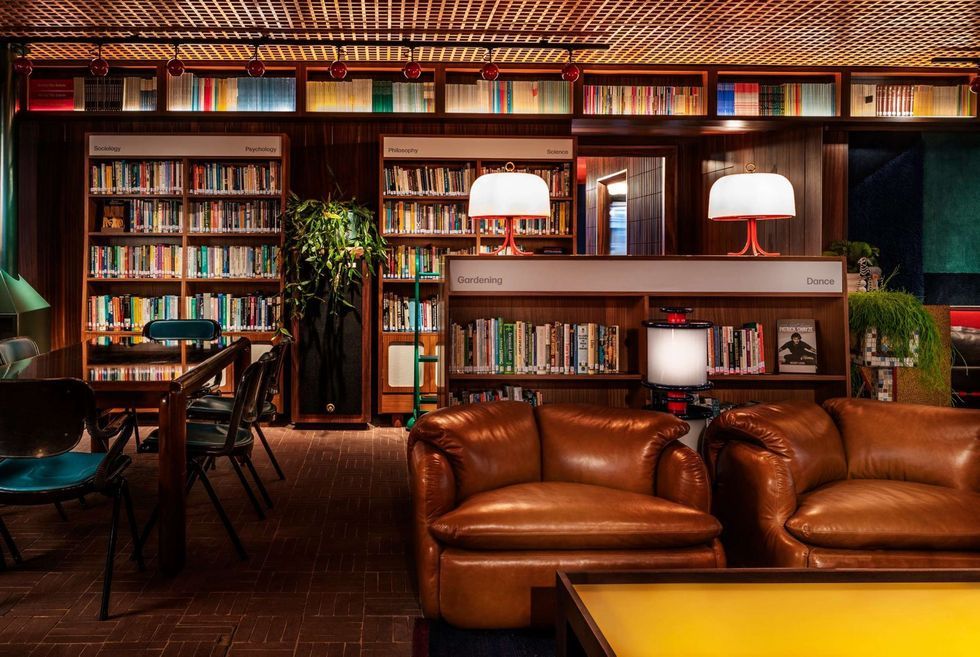
London can be an expensive place, but if you're coming for a relatively short stay suddenly the luxury hotel scene opens right up to you. There are few better cities in the world to have a short term blow out, where the building you're staying in is as memorable as the city around it. The best hotels in London are an experience in and of themselves.
Or maybe you're a Londoner who just needs to step outside of your own four walls, away from your own bed, for a night or two? If lockdown taught us anything, it’s that a change of scenery does us good every now and again.
Here we round up the best London hotels for a short, romantic stay. They range from the reasonable to the high end of the price scale, but they all have a special something to recommend them above the rest.
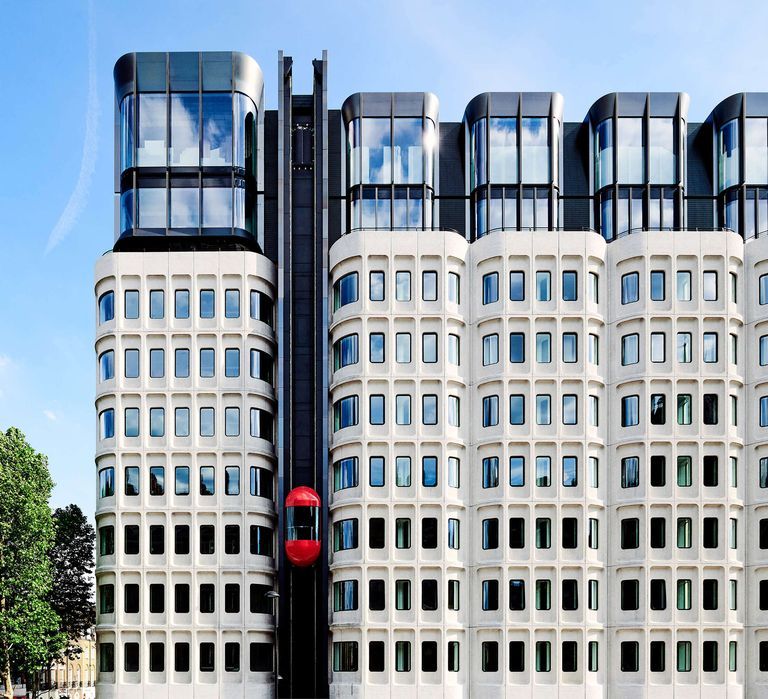
A red bubble lift is the only pop of colour on the beautiful brutalist facade of The Standard Hotel in King’s Cross (the group’s first London outpost), but it’s a sign of things to come. Walk inside, straight through to the open plan lounge/bar/restaurant, and you’ll be met with a tribute to confidently cool Sixties and Seventies interior design – Austin Powers' swinging London with a dash of counterculture Hollywood Hills; walnut panelling, soft leather sofas, furry walls and shag carpeting, geometric shapes and optical-art murals – all conceived by American designer Shawn Hausman. He was inspired by the building’s previous life as a library during that period, so you’ll find a selection of carefully curated books in the lounge too.
Venture up into one of the 266 rooms, and you’ll discover tastefully kitsch homages to London transport designs (in the rooms facing St Pancras), minimalist mixes of relaxing wood furnishings and plants (in the windowless Cosy Core rooms at the centre of the building), and in some of the suites towards the top of the building, an al fresco bathtub and private bars (as well as complimentary raincoats. Not quite as glamorous, granted, but very, very useful in London).
The luxurious suites would be a worthy location for a cocktail party, but there are already plenty of places to do that within the hotel: walk past the DJ-booth in the lounge and you’ll find the swanky Double Standard and Isla bar/restaurants (the former sells delicious dive bar staples, the latter seafood and small plates). Then there’s Decimo on the 10th floor, where Michelin-starred chef Peter Sanchez-Iglesias merges the Spanish food of his upbringing with the Mexican food he’s grown to love. And last but certainly not least, you can shoot up to the rooftop bar, which provides panoramic views across the capital (and a top tier cocktail menu, of course.) There are plenty of specials on, too, including a self-care suite and a 'stay for three, pay for two' deal.
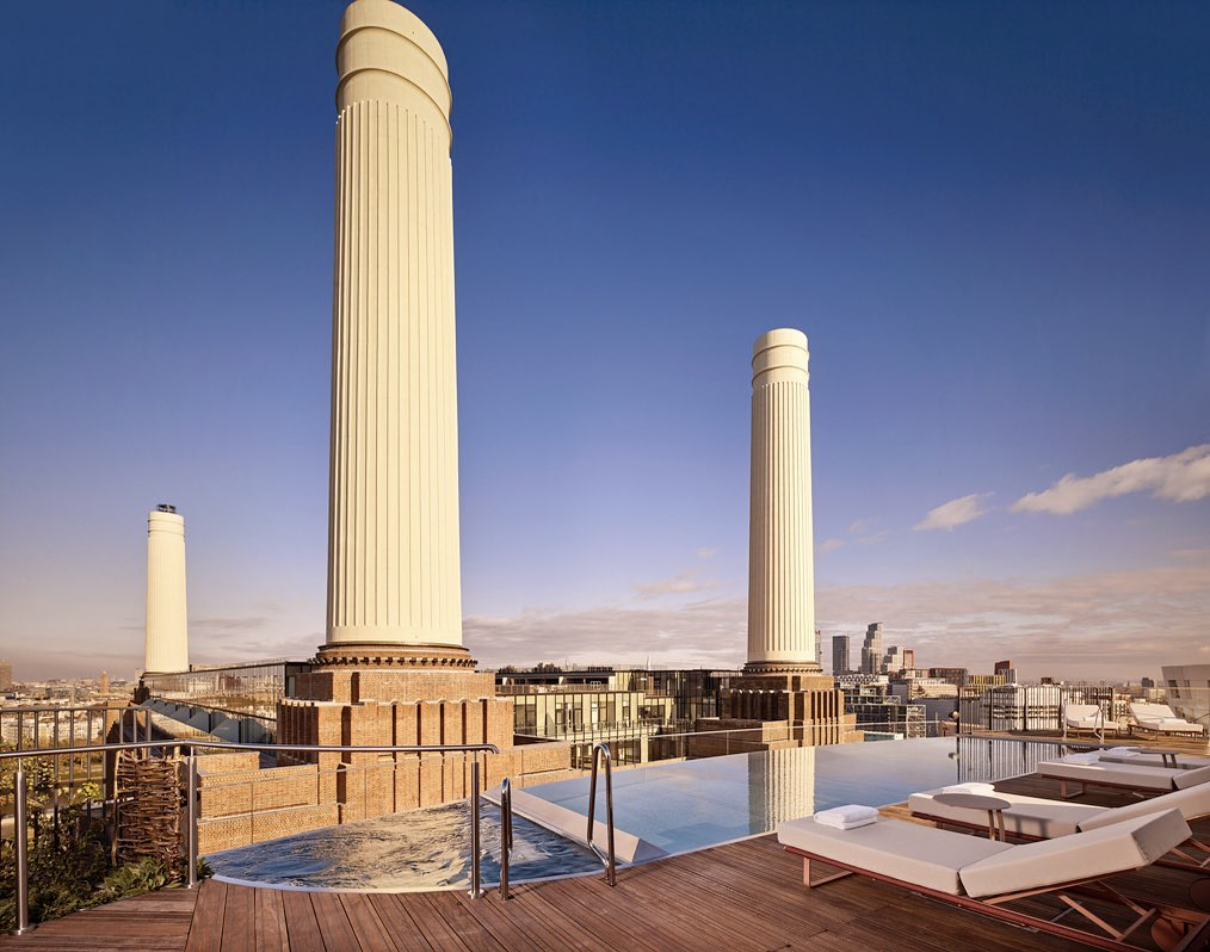
It’s strange to think that Bethnal Green Town Hall, the grand neoclassical building that looms over Cambridge Heath Road in East London, laid vacant for quite so long. The council moved out in 1993 but, bar some starring roles in Lock, Stock and Two Smoking Barrels and Atonement, it wasn’t until 2010 that the sprawling space was opened to the public again in the form of a five-star hotel.
The art deco interior has been largely maintained – a green and white marble staircase greets you as you enter the reception and, like so many British civic buildings that cropped up in the early century and ultimately aged out of use, there’s an interesting balance of the majestic and the everyday in its design. The rooms – there are 96, though only 12 are double rooms and the rest are suites, studios and apartments – are bathed in natural light thanks to the high windows, with innovative layouts that set the hotel apart from competition and serve as a constant reminder of the building’s former life – the most striking room, by far, is the grand triple-height De Montfort Suite, with its arched windows, stained-glass panelling and abundance of space. Then there’s the heated indoor pool, a rarity for luxury London hotels, and an in-house restaurant, too.
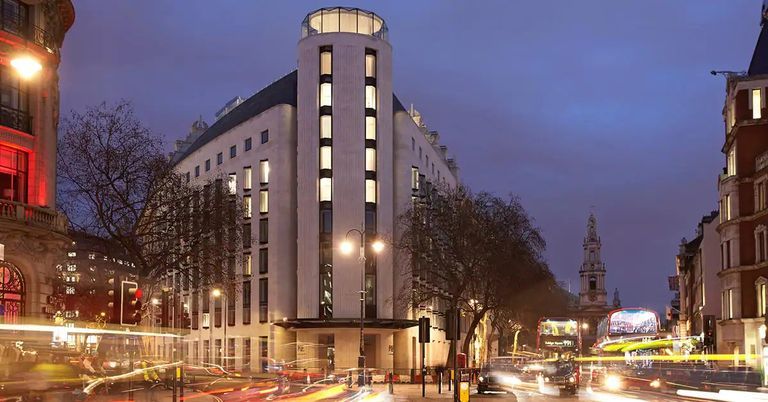
It's hard to imagine a slicker all-round package for a one-night weekend stay than the Foster & Partners-designed ME hotel in the old Marconi building at one end of the Aldwych opposite Waterloo Bridge. From the moment you arrive in the reception area which features an impressive 30 metre atrium, it's hard not to feel as if you have docked onto a luxury space station. The minimalist and monochrome rooms are cleverly kitted out and include various light settings which only add to the sci-fi feel. Upstairs is a very cool terrace which serves brunch during the day and becomes a destination bar by night.
The STK steak restaurant is glamorous and buzzy, while the in-house Italian is a little more laid-back. Oh, and did we mention the location that perfectly straddles East and West, and is within throwing distance of a post-checkout stroll along the Thames or shopping trip to Covent Garden. A booking you won't regret.
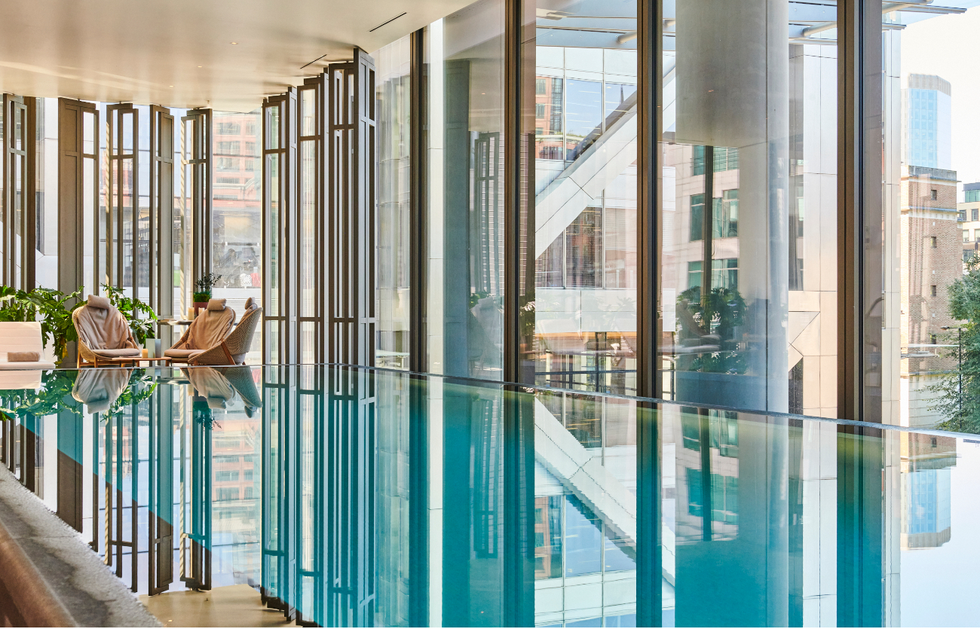
A mere stone’s throw from Liverpool Street Station, amidst all the swinging briefcases and beer-swilling commuters, sits an unexpected oasis of calm. You’ll get the vibe as soon as you look up to see swimmers perched up at the Pan Pacific’s 18.5m infinity pool: this is a hotel to relax in.
The neutral tones and soft interiors, aided by an abundance of natural light, immediately make you feel at ease, but that’s the least of it. Beyond the aforementioned swimming spot, loungers and accompanying spa sessions, you’ll have the chance to take part in the hotel’s new innovative Rest, Recharge and Rejuvenate sleep program.
The big attraction is the revolutionary Ooler Sleep System, which you can use to heat up each side of the bed to different temperatures (underneath a Mela weight blanket, for good measure.) Then there’s the Pañpuri aromatherapy oils, to ensure you’re properly loosened up. If you want the meditative calm of a spa getaway but still want to be surrounded by the buzz of the capital, then this is a top choice.
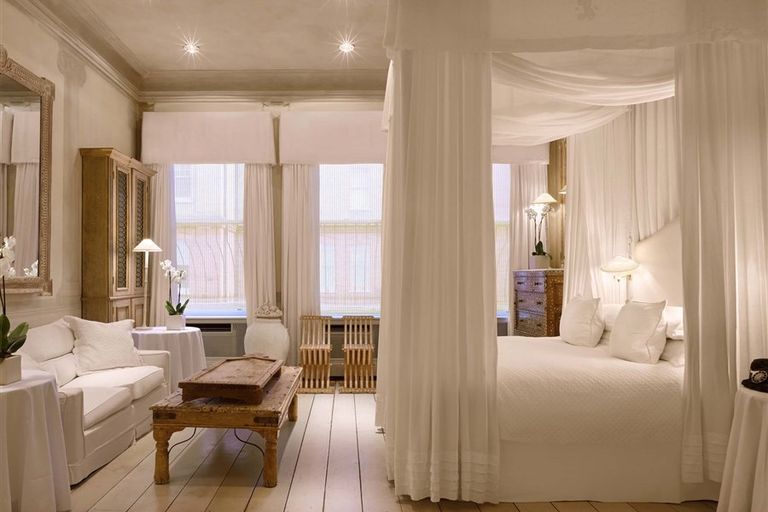
This magnificent 5 star Kensington boutique can lay claim to being perhaps London's most stylish hotel for numerous reasons - from the Victorian town house exterior to the gorgeous bar area - but it is the rooms that really stand out. Originally established by the celebrated designer Anouska Hempel, each one is the essence of unfussy sophistication full of delightful details. Not for nothing is Blakes a cult choice among many of the capital's visiting artists and designers.
Food-wise you're onto a winner too. The restaurant, freshly renovated as of last summer, aims to conjure up the interior of 'a beautiful old fashioned steamer sailing up the Bosphorus'. Quite how accurate that is we're not sure, but the contemporary, Mediterranean-influenced menu attracts non-guests from all around the city for good reason (we recommend the grilled octopus and lobster paccheri pasta) - intimate and cheerful yet glamorous, it is one of the best dining spaces in London.
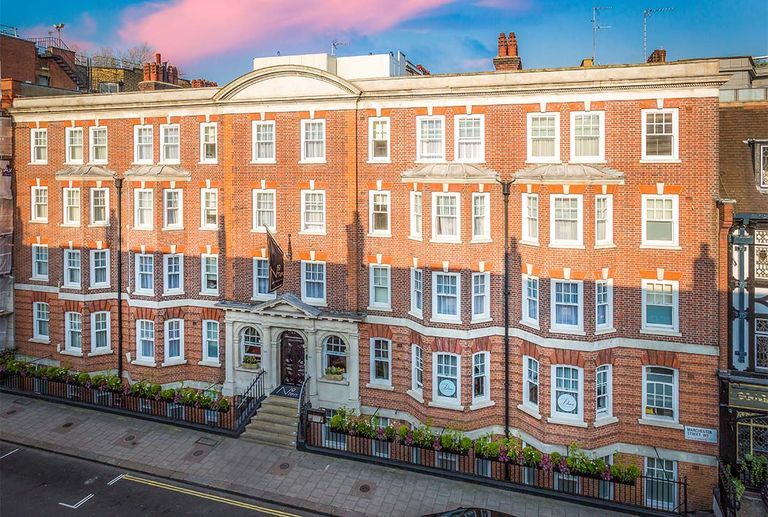
From its glorious West London red brick façade through to its smart, chic rooms and excellent in-house restaurant, No. Ten Manchester Street is a classic example of a four star hotel that feels by and large like a five star. Throw in one of the best locations imaginable for a relaxed exploration of the city away from the chaotic tourist beats of Trafalgar Square et al, and you’ve got a great option for any weekend stay.
Even more so, at the moment. The hotel has rustled up a package deal in which guests can enjoy a two-night stay in an executive room that includes an experience at nearby cheese mecca La Fromagerie. The small, charming restaurant is a perfect romantic spot to dip some charcuterie and potato in a classic Fondue Savoyarde – washed down with a crisp Chignin Vers les Alpes. It’s an Alpine treat, only with no mountains outside. Unless you decide to climb the Tower of London afterwards, we suppose. Hurry, though: the £315 package ends this year.
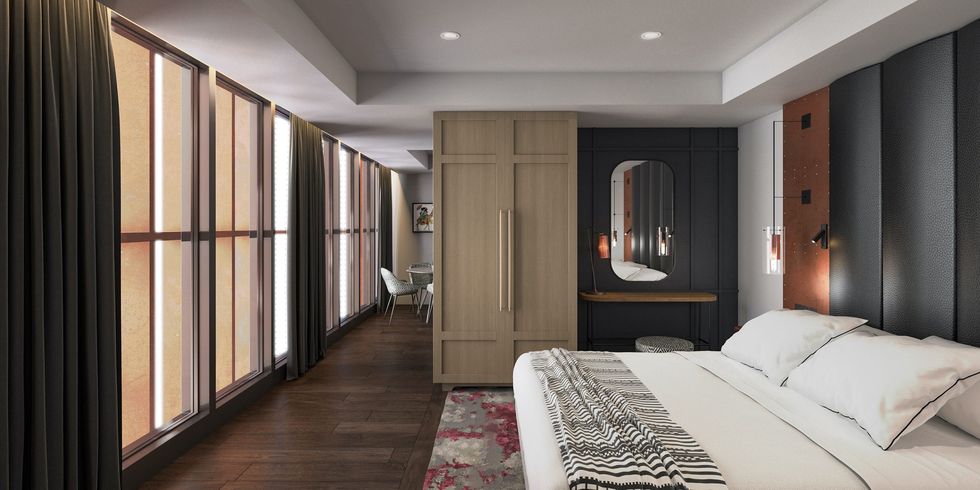
If you like to shop, this is by far the best (and nearest) place you can drop. Situated just around the corner from the UK’s biggest shopping centre Westfield Stratford City, The Gantry’s sleek, dark, and lightly industrial interiors make it the ideal place to unwind. The thoroughly modern hotel is kitted out with smart TVs and waterfall showers, while floor-to-ceiling windows allow incredible views of the surrounding skyscrapers.
The jewel in the hotel’s (mid-century modern) crown, however, is the Union Social terrace, complete with comfy armchairs and fire pits that allow you to eat and drink while watching the sun sink behind the skyline. A Sicilian chef heads up the hotel’s Union Social restaurant, which serves an abundance of pasta and fish dishes, as well as salads and small plates. The hotel even has a set menu for fans attending the nearby ABBA Voyage concert in the Queen Elizabeth Olympic Park (yes, Swedish meatballs are on the menu).
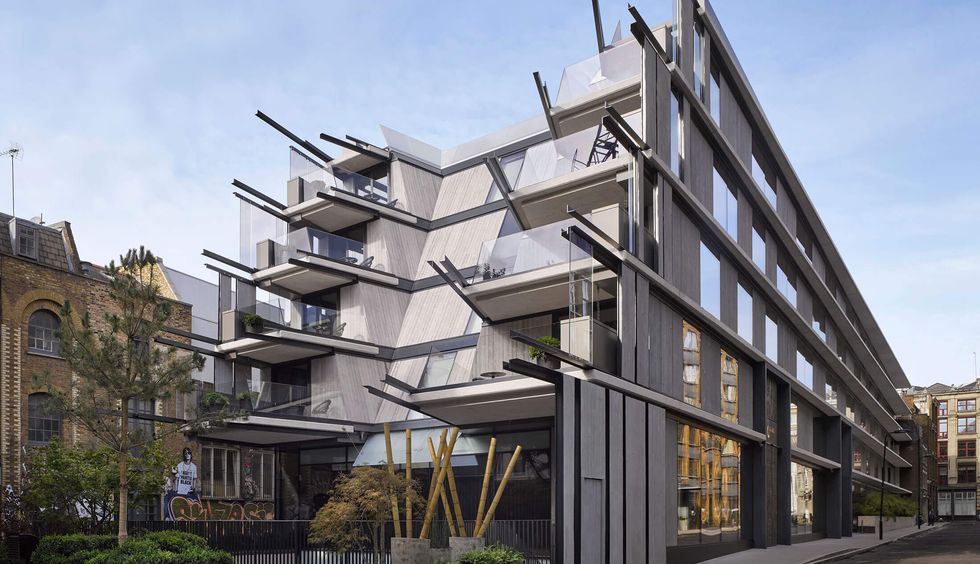
You could convince us to book a stay at just about any hotel with the suggestion that Robert De Niro might, maybe, almost-definitely-not-but-who-knows, be checking in too. The American actor co-founded Nobu in 1994; first as a Japanese-Peruvian restaurant in New York with celebrity chef Nobuyuki “Nobu” Matsuhisa and film producer Meir Teper, then as eight luxury hotels spread across five continents (and 38 more restaurants for good measure.) What better chance to hand him your game changing screenplay (“Goodfellas in space”)?
But Nobu has a lot more going for it than the occasional sight of De Niro picking at some black cod. London’s original outpost landed in Mayfair in 1997, but it took twenty years until a hotel would arrive in the capital – first in Shoreditch, then another in Portman Square, during the uncertain days of lockdown. The latter is inspired by the pale wood Japanese minimalism of the since-closed Berkeley Street restaurant, while the 164-room East London location, a former multi-story car park, is a characteristically edgier offering. Brutalist-inspired concrete abounds; an orthogonal series of rooms recline over Willow Street, metal fixtures jutting out of the building’s façade. The dark wood suites are beautiful and spacious, the standard rooms tastefully designed. It recently enjoyed the addition of two skyline suites and a private rooftop terrace.
When it comes to grabbing dinner at the restaurant, let the waiter take the lead on menu choices (it’s a big one, and they’ll make sure you get a taste of the classics). Just rest easy... and leave Robert De Niro alone.
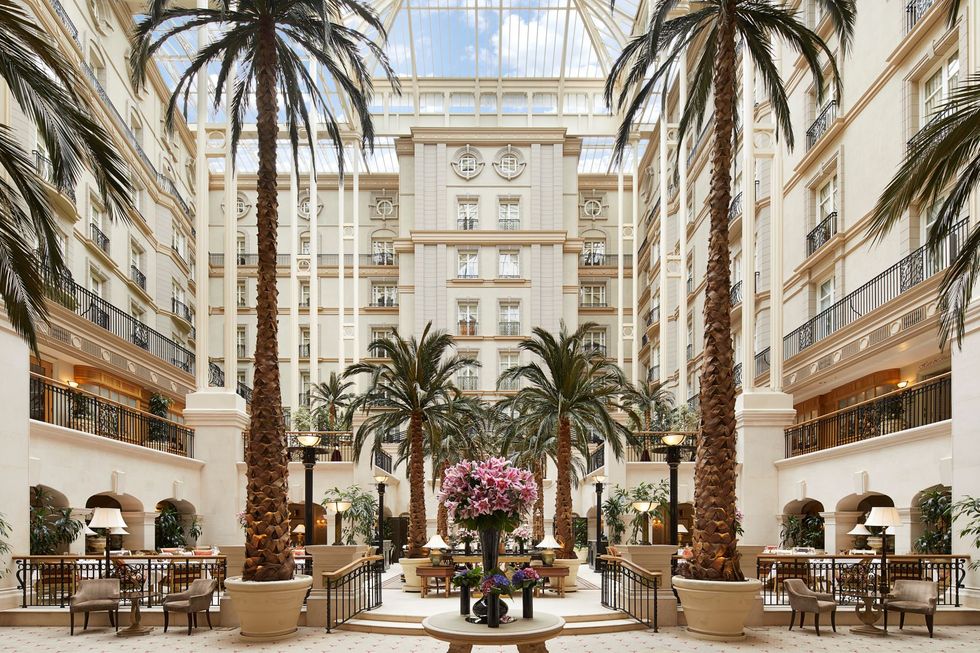
In a city not exactly short on impressive dining spaces, the restaurant at The Landmark London still manages to be breathtaking. Positioned beneath an eight-storey glass roof and lined with palm trees and balconies, the effect is feeling like you're in an exotic outdoor plaza in sunny climes rather than a 5 star hotel a stone's throw from Baker Street.
Luckily, the food matches the setting, with sumptuous modern-European cuisine served by night and one of the best breakfasts in the city come morning. The rooms, too, are delightful: tasteful and spacious.
The Landmark London is charmingly old-fashioned (afternoon tea is still a cornerstone of its appeal, as is the slightly chintzy decor), a quality that extends to a quietly luxurious atmosphere and impeccably attentive staff.
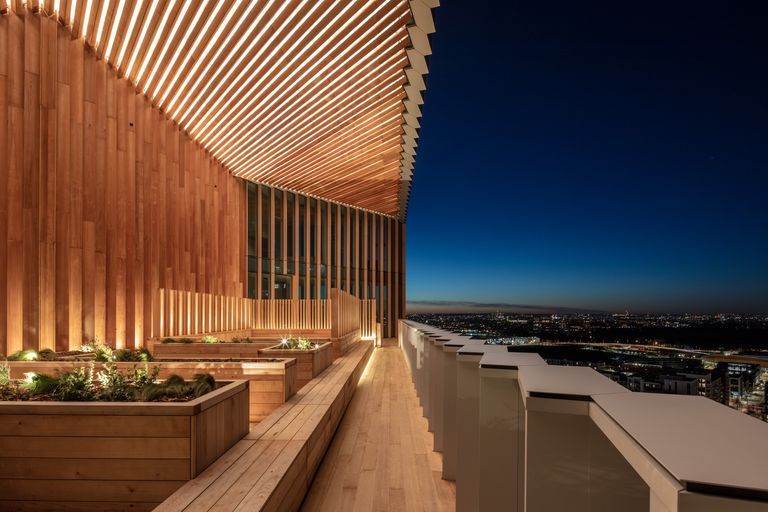
Walk out of Stratford International Station, look up, up and up again, and you’ll be met with one of London’s most unique skyscrapers: the Manhattan Loft Gardens. Opened in the summer of 2019 and dreamed up by the architects behind the Burj Khalifa and One World Trade Centre, this double-cantilevered tower is sliced open by gravity-defying sky gardens and features both apartments and a hotel, which is all part of an ambitious plan to create a ‘vertical community’ in the skyline of the rejuvenated postcode.
The hotel is called The Stratford, and it occupies the first seven floors of the building. And while you’d expect the glass-panelled drama to follow you inside, things become far more calming as soon as you enter. Danish design studio Space Copenhagen, who were responsible for the first Noma restaurant, have given the interior an airy Scandinavian feel, with high ceilings, mid-century furnishings and earthy tones throughout. The impressive rooms are just as understatedly luxurious and soothing, with stone bathrooms, soft bedrooms and floor-to-ceiling windows – which means plenty of great natural lighting for all those braggy Instagram photos you’re bound to take.
In terms of food options, there’s the much-raved-about Allegra restaurant on the seventh floor and Kitchen E20 by the entrance. The latter is overseen by Head Chef Josh Deacon (formerly of the Rail House Café), who arrived after lockdown and has crafted a modern British menu with an Australasian influence. Like everything else at The Stratford, it is unpretentious and impressive. Then there’s the sky terrace on the seventh floor – well worth the entry price alone.
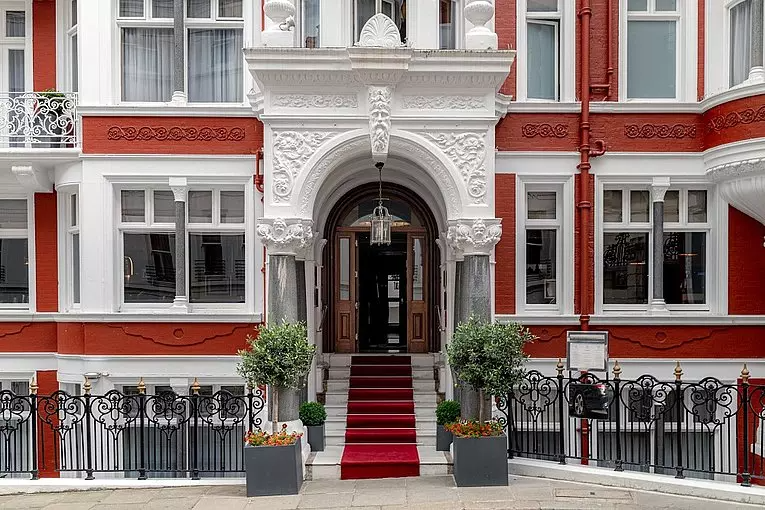
If you’re looking for luxury, why stay anywhere but the most expensive square on the Monopoly board? Situated in the aorta of Mayfair, St. James is a five-star boutique hotel with classic British charm: it’s impossible not to feel like an old-school aristocrat when walking up its red-carpeted stone steps. The hotel is small enough that service feels personalised and attentive, and with Buckingham Palace just a ten-minute walk away, this is the perfect place to gain royal pretensions for a weekend.
Having the king for a neighbour is one thing, but on-site Michelin star restaurant Seven Park Place is the hotel’s real selling point. Head chef William Drabble serves up seasonal French menus – the £140 Gourmand tasting menu is an unmissable experience where you can sample everything from scallops to pheasant to Baron Bigod brie, all served in a light, bright dining room.
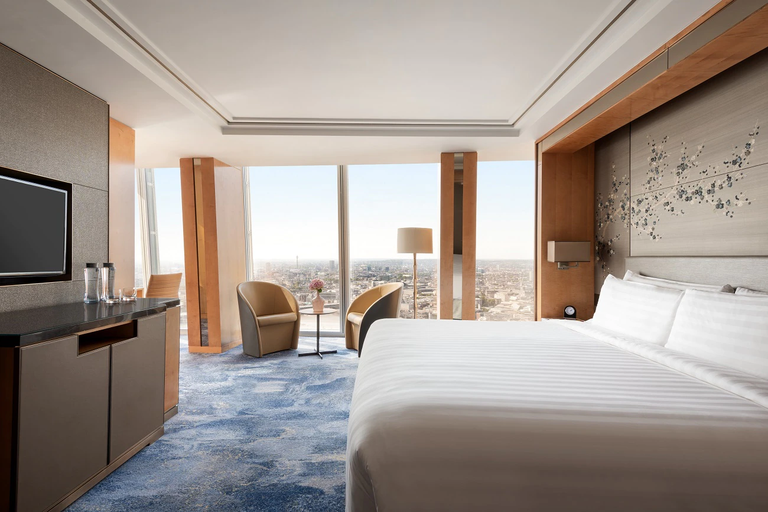
The real reason to pick the Shangri-La over any other luxury hotel in London is, of course, the breathtaking views. Located at the top of The Shard – the capital's tallest (and increasingly iconic) structure – the whole of the city is on display, whether you're eating, swimming or propped up on your bed. Watching the light change in the sky as London sleeps, wakes, works and plays is really something special. Luckily, the hotel and its staff do not rest on their laurels as a result of the Shangri-La's huge advantage – the rooms are immaculate, the European-Asian food and inventive cocktails superb (at TĪNG and GŎNG respectively) and the indoor pool at (almost) the very top is a small slice of heaven. Then even run regular Cultural Salon events too – the first was with designer Paul Smith, with many more exciting speakers planned for the year ahead.
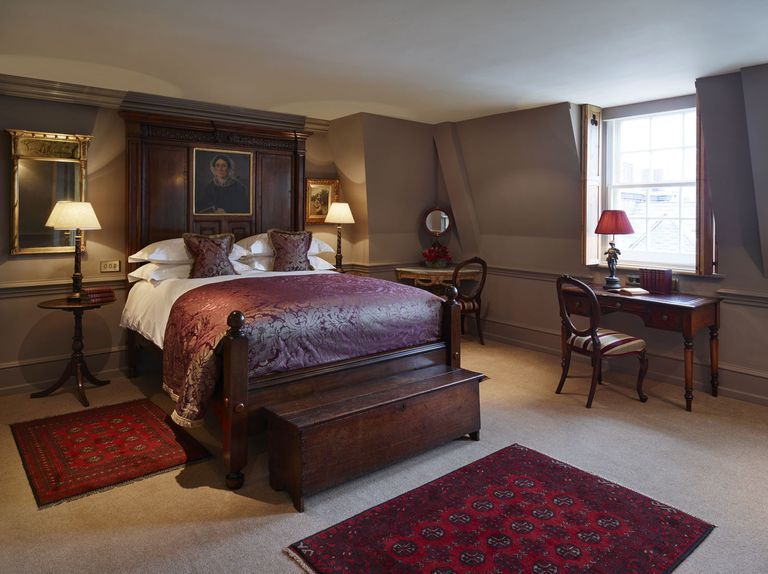
It's hard to know where to begin describing this boutique hotel in Shoreditch, so let us start by listing some things it is not: modern, sleek, minimalist, boring. Instead, it's a slightly bonkers, absolutely beautifully designed and fantastically original Downton Abbey-esque bolthole situated (somewhat incongruously) on the cusp of East London's trendiest quarters. Full of books, fireplaces and ornate touches, it bucks every contemporary trend for hotels and is all the better for it.
There is no restaurant at Batty Langleys (although a wonderfully cosy and well-stocked honesty bar is free to use and they will deliver an A+ bacon sandwich to your room for breakfast), meaning most of the focus has been put onto the rooms. They are uniformly stunning - lavishing appointed with cheeky and surprising design details (one has a toilet accessible via hidden door in the book case). It really is like stepping into another era, and yet the feel is fun, not stuffy. For an imaginative choice in a great part of town, look no further.
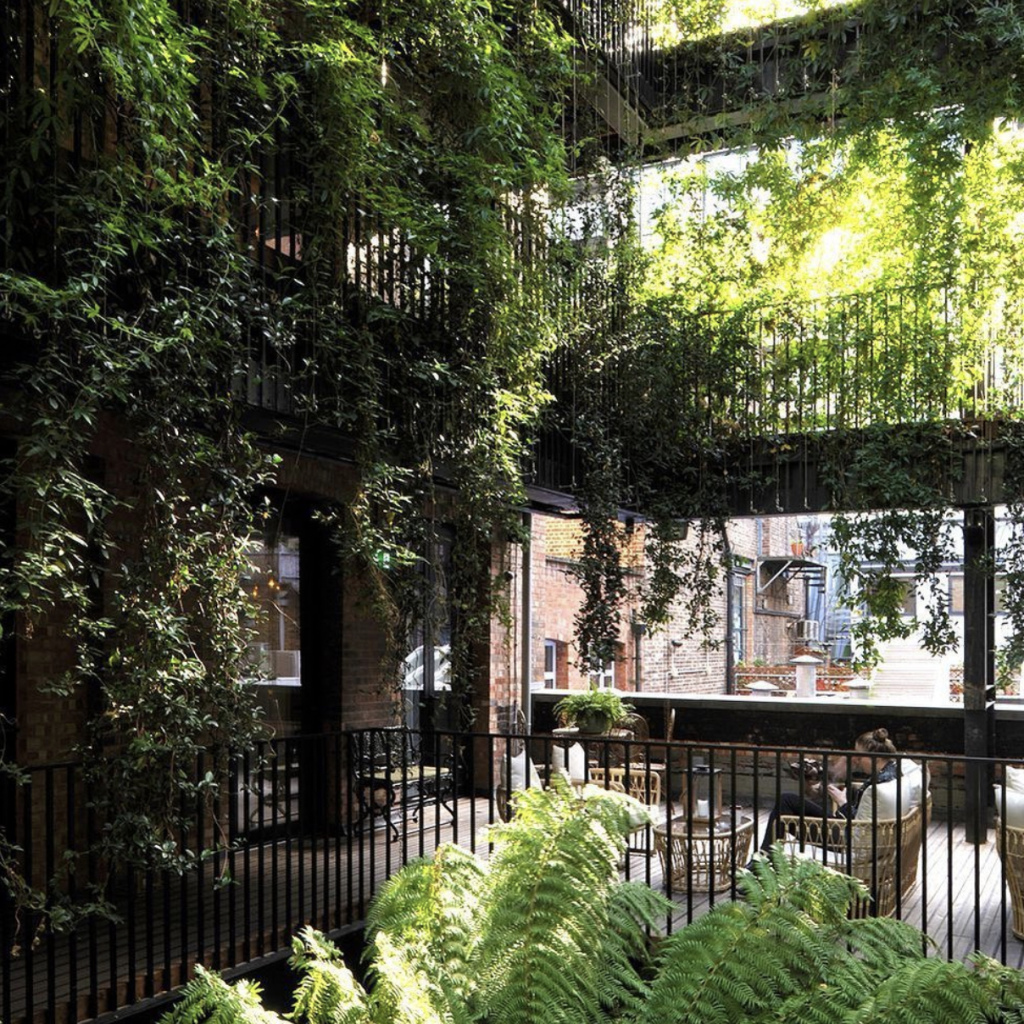
This five-star boutique hotel might sit minutes from Oxford Street, but The Mandrake mercifully feels like a world away from that long drag of American candy stores and closing down sales. It sits inconspicuously on Newburgh Street, easily missed if not for the waiting doorman and the feathered eye that looms above the entrance. A quiet locale gives way to a dark, club-like lobby that continues into the slim bar and around to Yopo, the Latin-American fusion restaurant. The food is very good, particularly the crudo, and the music isn’t as conversation-crushing as you might fear. There’s a open-air courtyard too, boasting palm trees and nice tiles and a bunch of other stuff that will help you forget that you’re within axe-throwing distance of an axe-throwing bar; walk out and look up, and you’ll find its surrounded by a beautiful three-story hanging garden, divided by wooden terraces that host most of the hotel’s 34 diminutive but distinctively designed rooms, as well as a greenhouse. From the library to the bar, it’s a social hotel at heart.
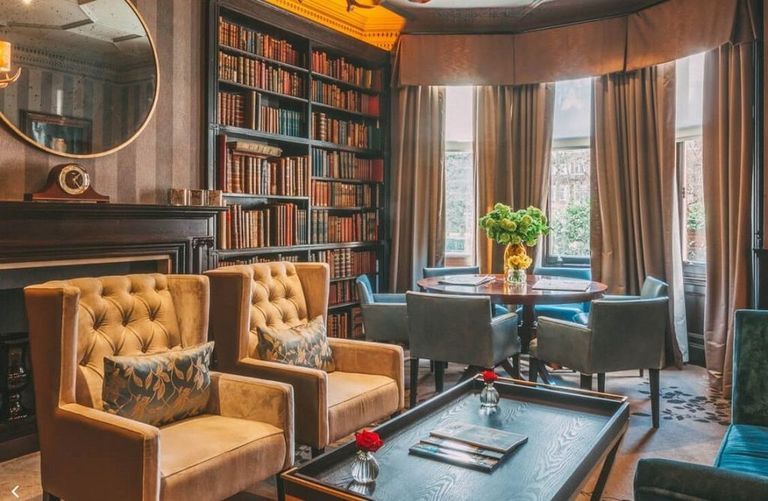
From the entrance onwards, it is clear that a visit to 11 Cadogan is a visit to one of London's most aesthetically pleasing boutique hotels. Inside the sumptuous drawing room, library and terrace only enhance this impression, as do the glorious staircases. Classically British in design, you'll fall for the place right away - and that's before you've even reached the stunning bedrooms - feeling for all the world like the head of an important Victorian townhouse. If you're looking to explore Chelsea and Knightsbridge, you won't find a more relaxing and satisfying base than this.
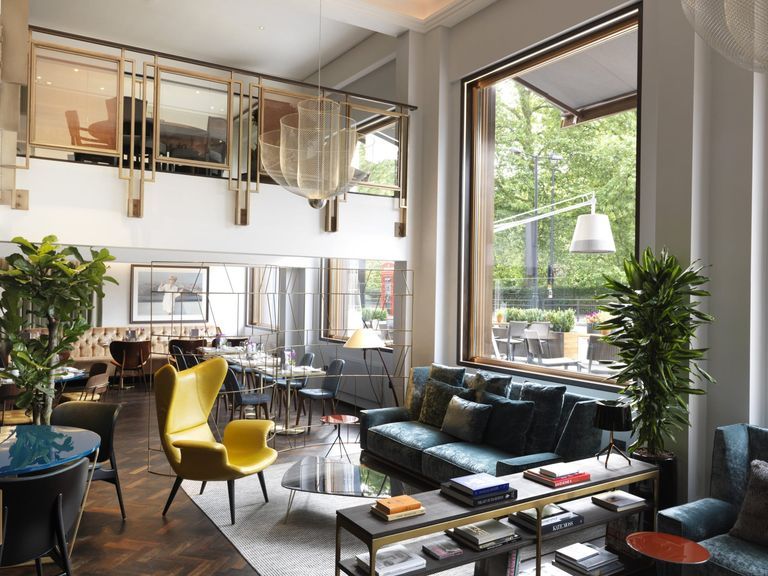
This family-run 5-star hotel in Mayfair is as charming and perfectly located a spot as you could wish for, with one significant upperhand over most its rivals. 270 bottles decorate their specially appointed whisky bar, manned by an expert Sommerlier. Walk in an amateur, leave an expert in the greatest drink of them all, and what foods to pair it with.
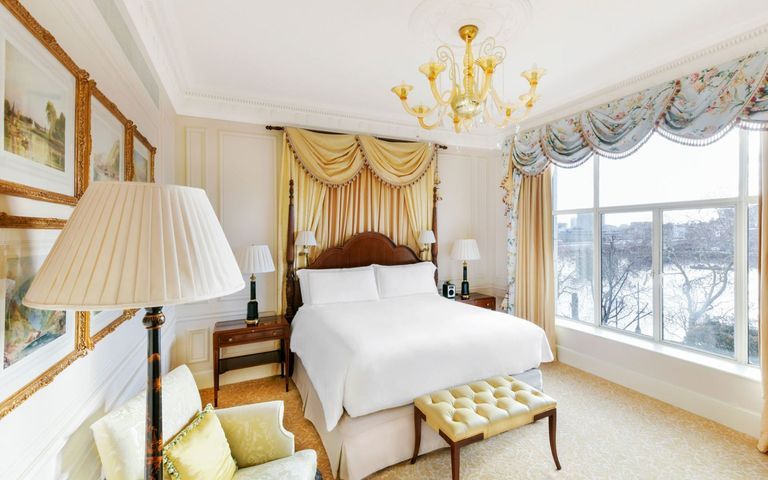
The name alone conjures the height of British glamour, as it has more or less since the doors first opened in 1889 when it was London's first and only luxury hotel. Today, the rich history of The Savoy sits comfortably alongside first class modern service and facilities – the art deco of the famous American Bar is joined by the contemporary luxury of the Beaufort Bar, and a traditional roast – still one of the best in town – is available, besides the best in modern seafood at Kaspars. Decades on, The Savoy is still among the very best places to stay in town, and no where else can match it for basking in the sense of historic splendour, and thinking of the innumerable famous faces who have passed through it before you.
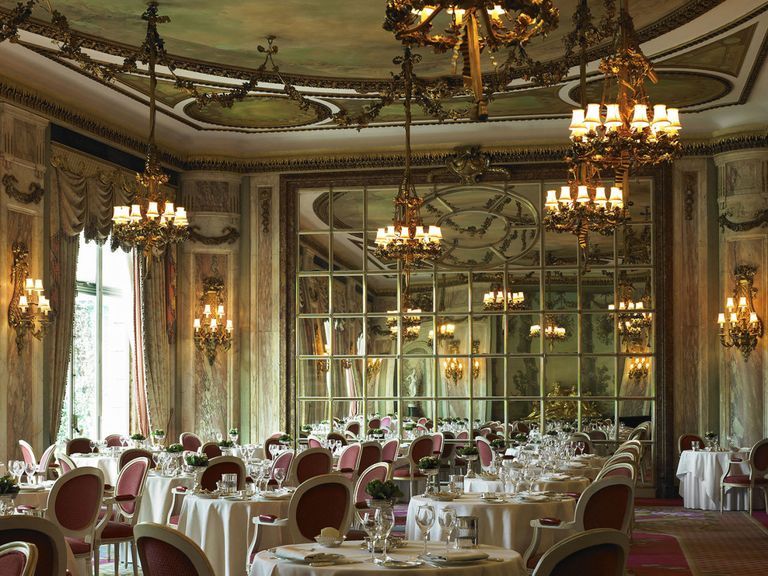
The name of this hotel is so tied up in our idea of luxury and British history, it can be hard to believe it actually exists. That sense of unreality is only heightened by actually walking through the doors, where you enter another, far more refined world in which every corner of the building is lavishly appointed and the staff - understandably - ooze with pleasure at where they work. Not for nothing is the Ritz where the royal family prefer to stay: within seconds you feel like royalty, too.
The stunning dining areas - topped by the main restaurant which ranks among the grandest in London - serve peerless British fare, while our favourite spot is definitely The Rivoli, a small bar made up of conspiratorial hubs and corners where the cocktails hit the sweet spot (so often missed in London) between classic and inventive. The rooms are as you'd expect: huge and traditionally glamourous. The Ritz is in one of the best posts in London. Plus there's plenty of shopping options nearby – and if the stay has already put a big dent in your bank account, then you can bypass Mayfair for the relative affordability of Soho, which hosts many of our favourite menswear brands (Sunspel, Oliver Spencer, Universal Works) as well as brilliant restaurants and historic pubs (The Coach & Horses on Greek Street is a particular highlight, ditto The French House on Dean Street).